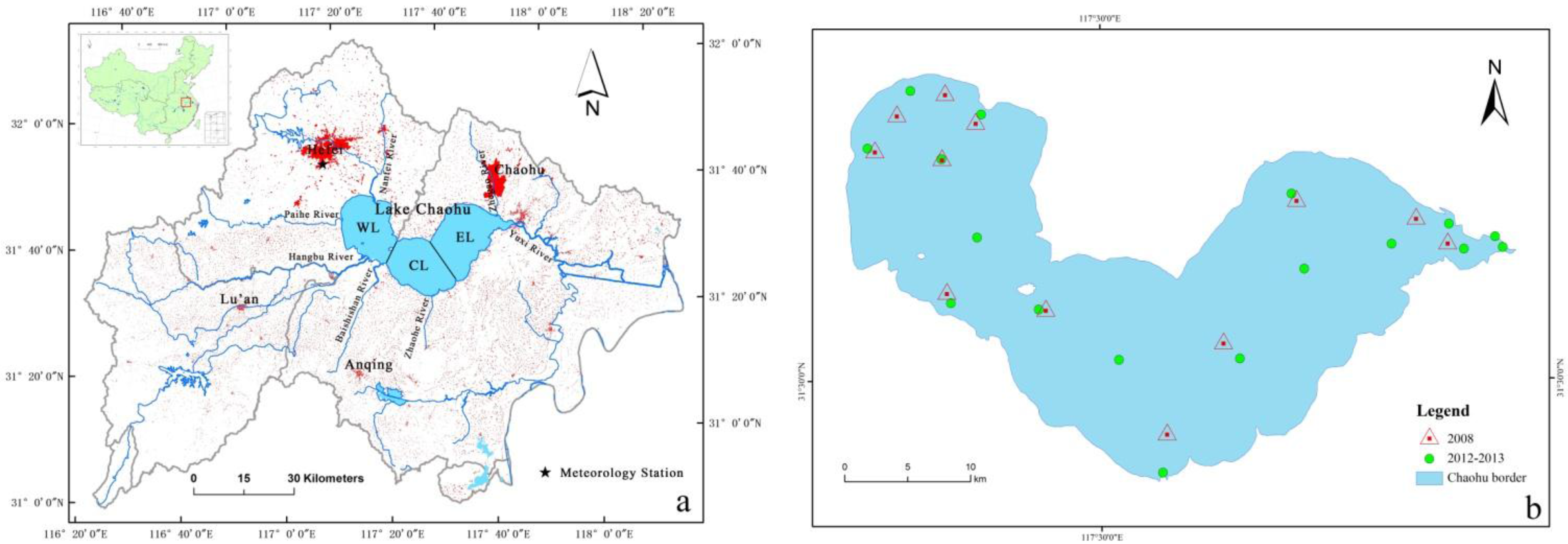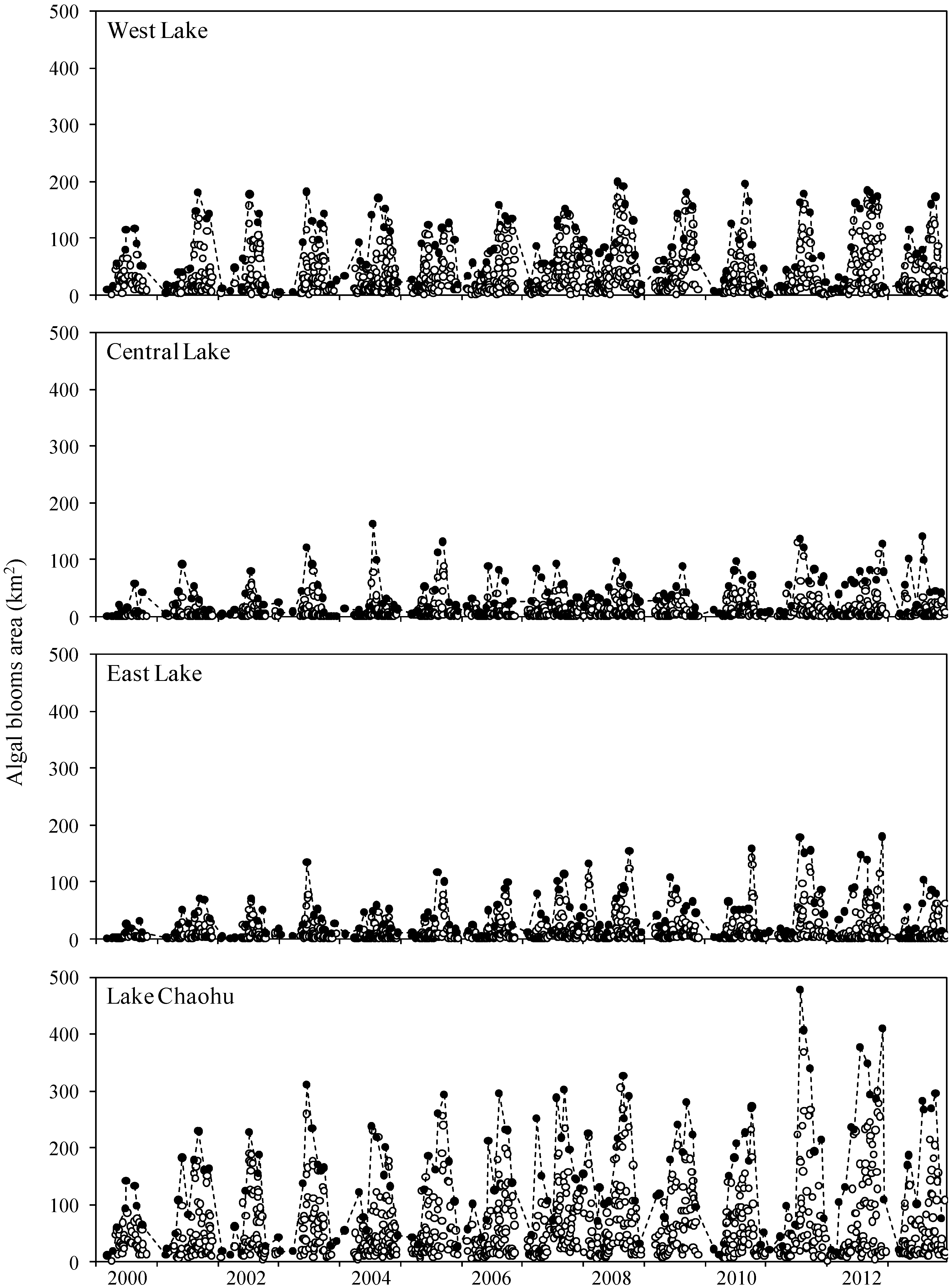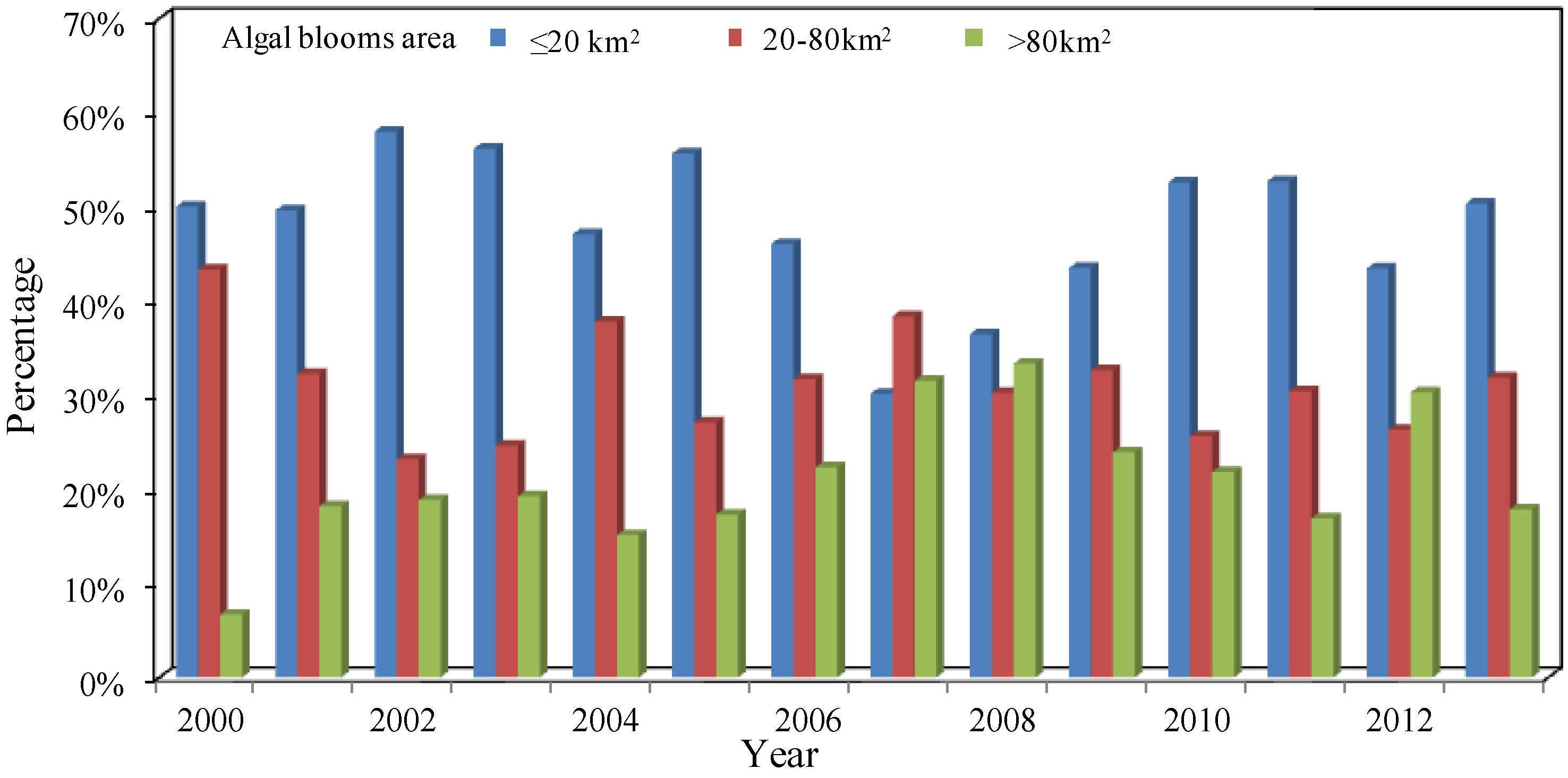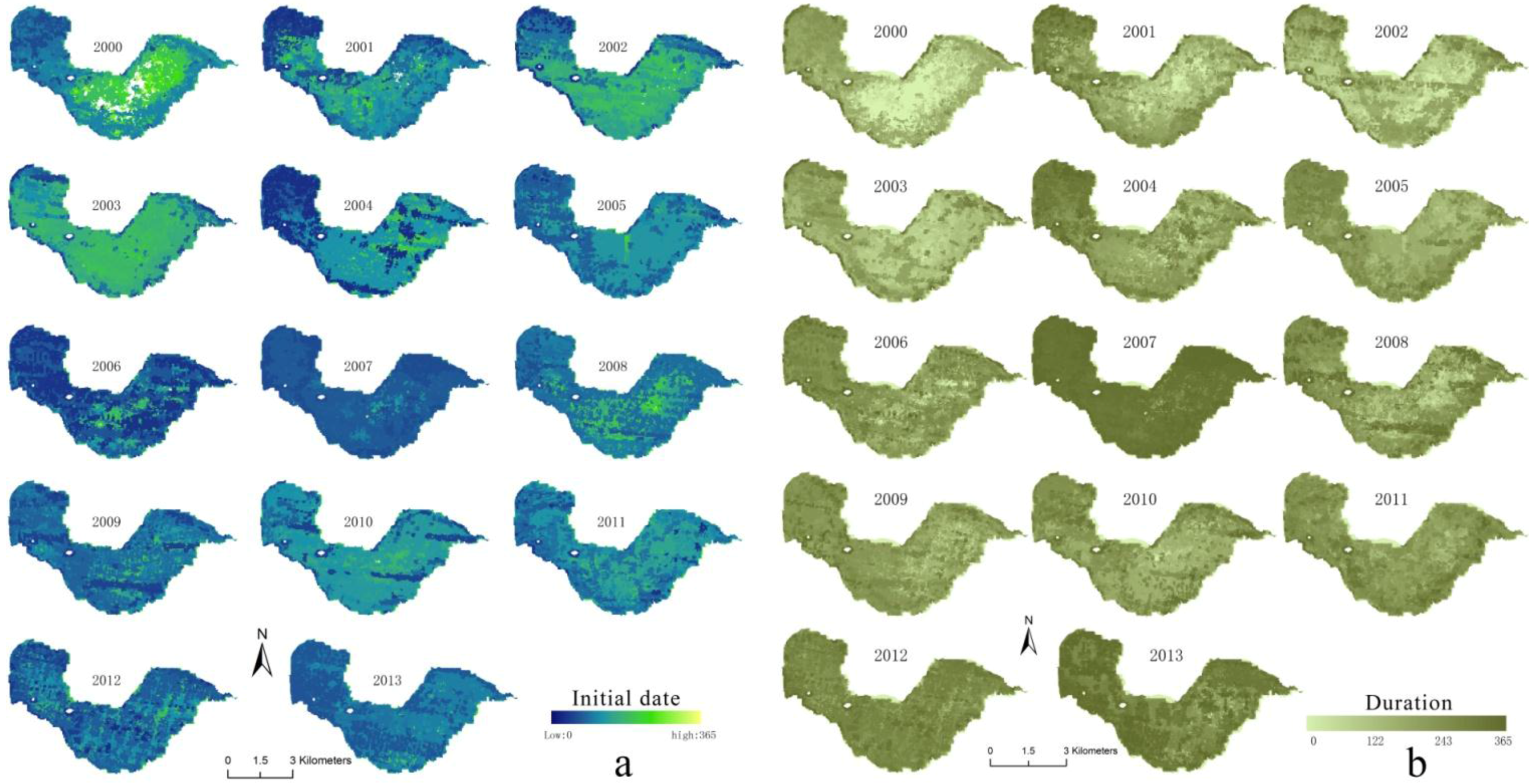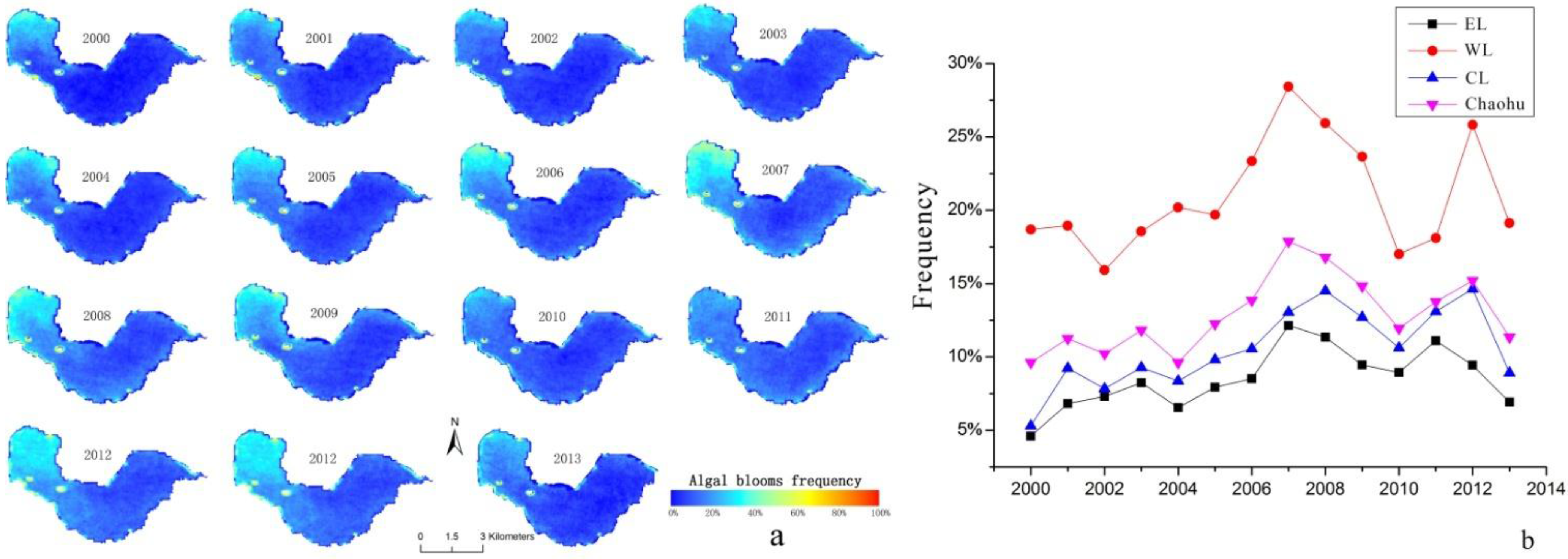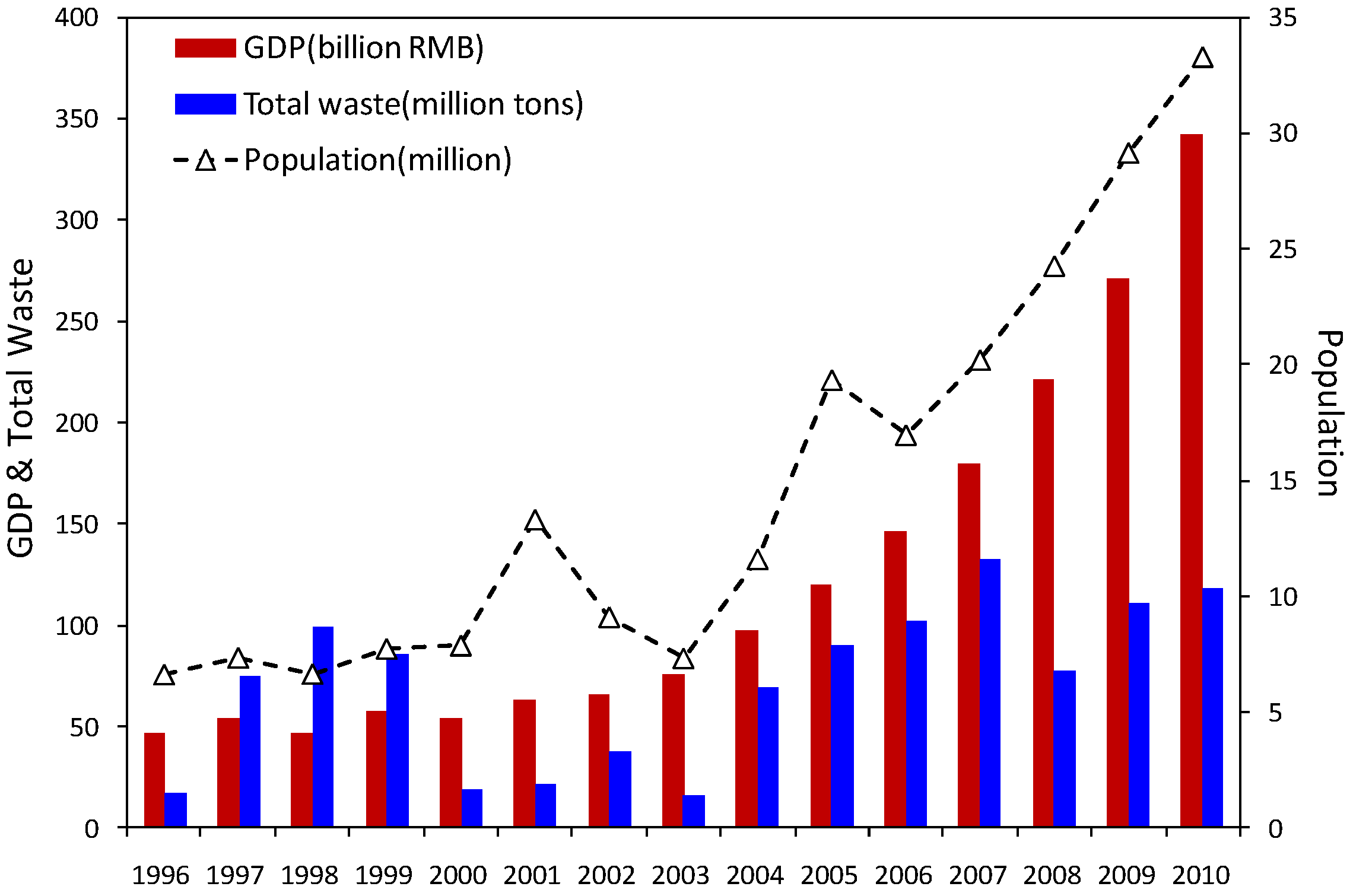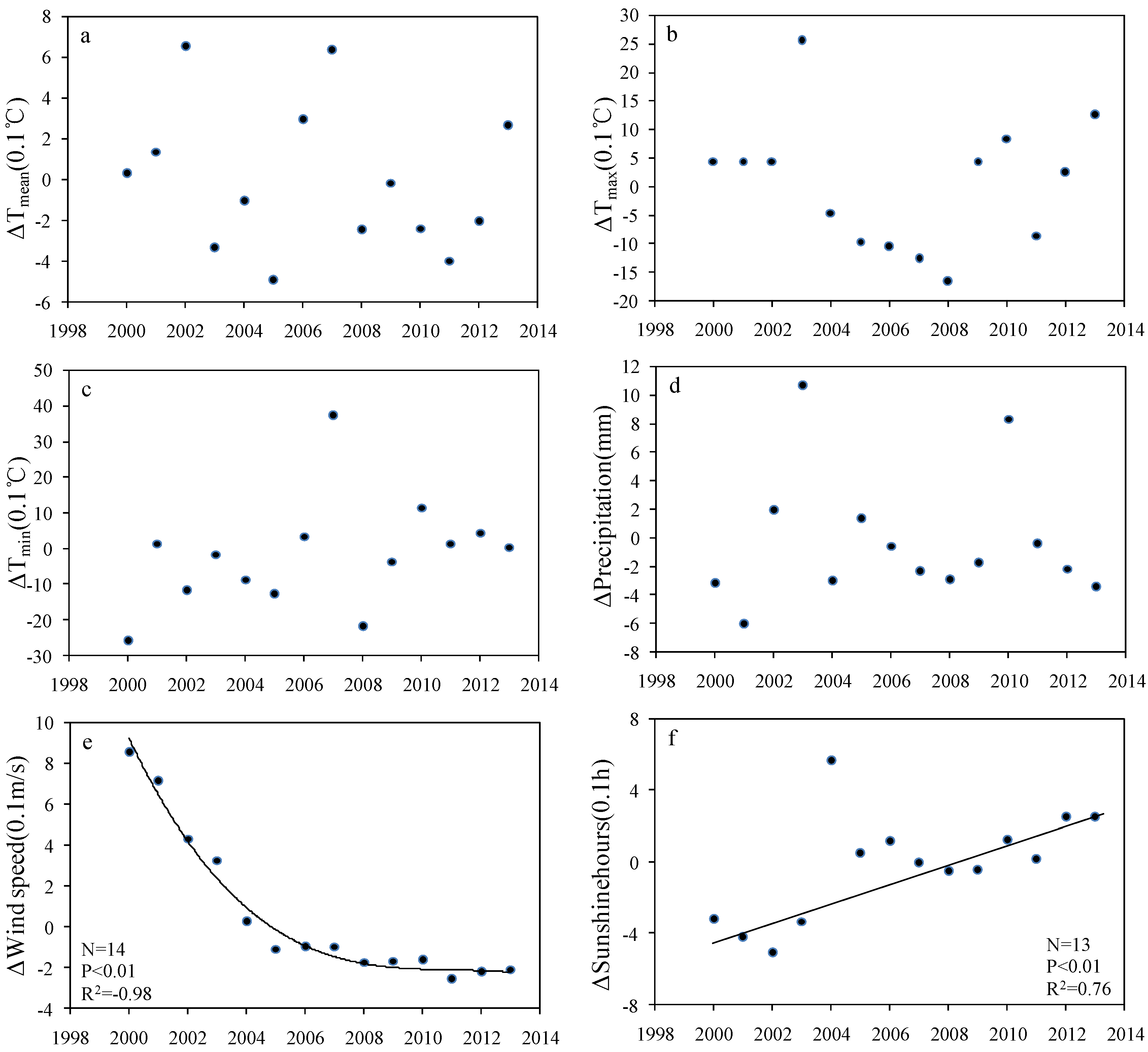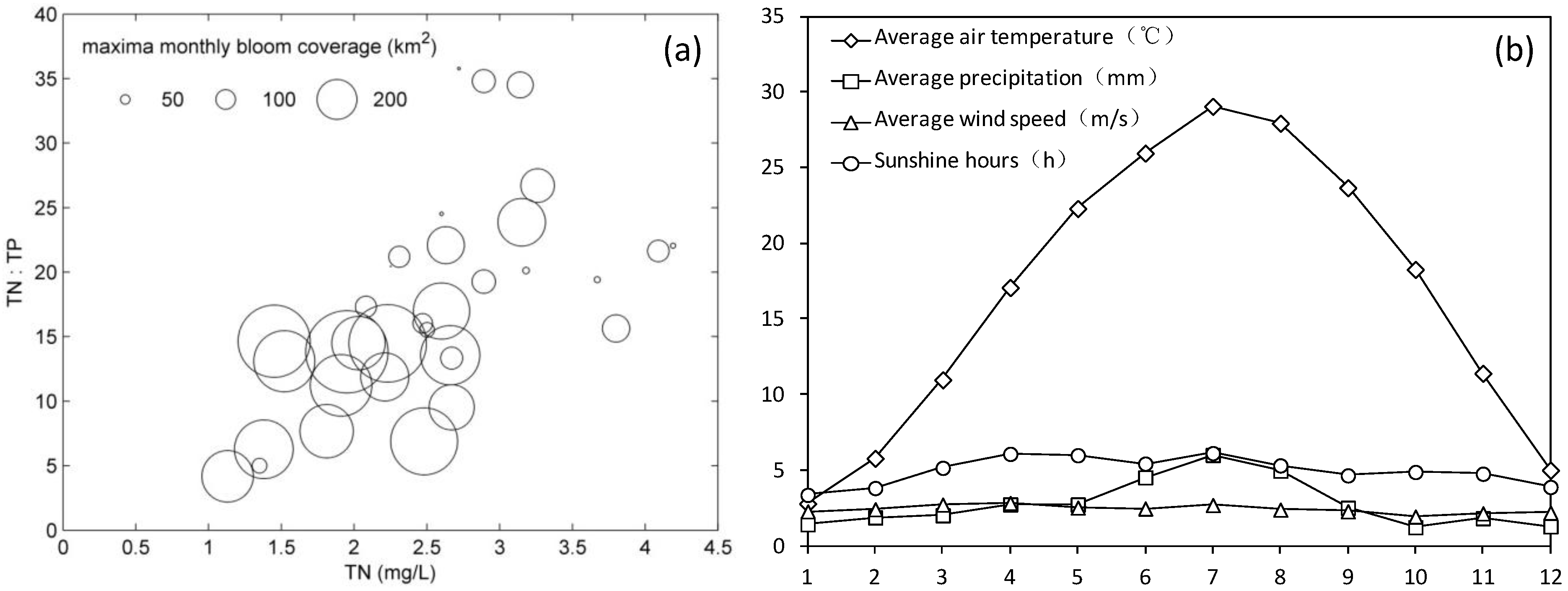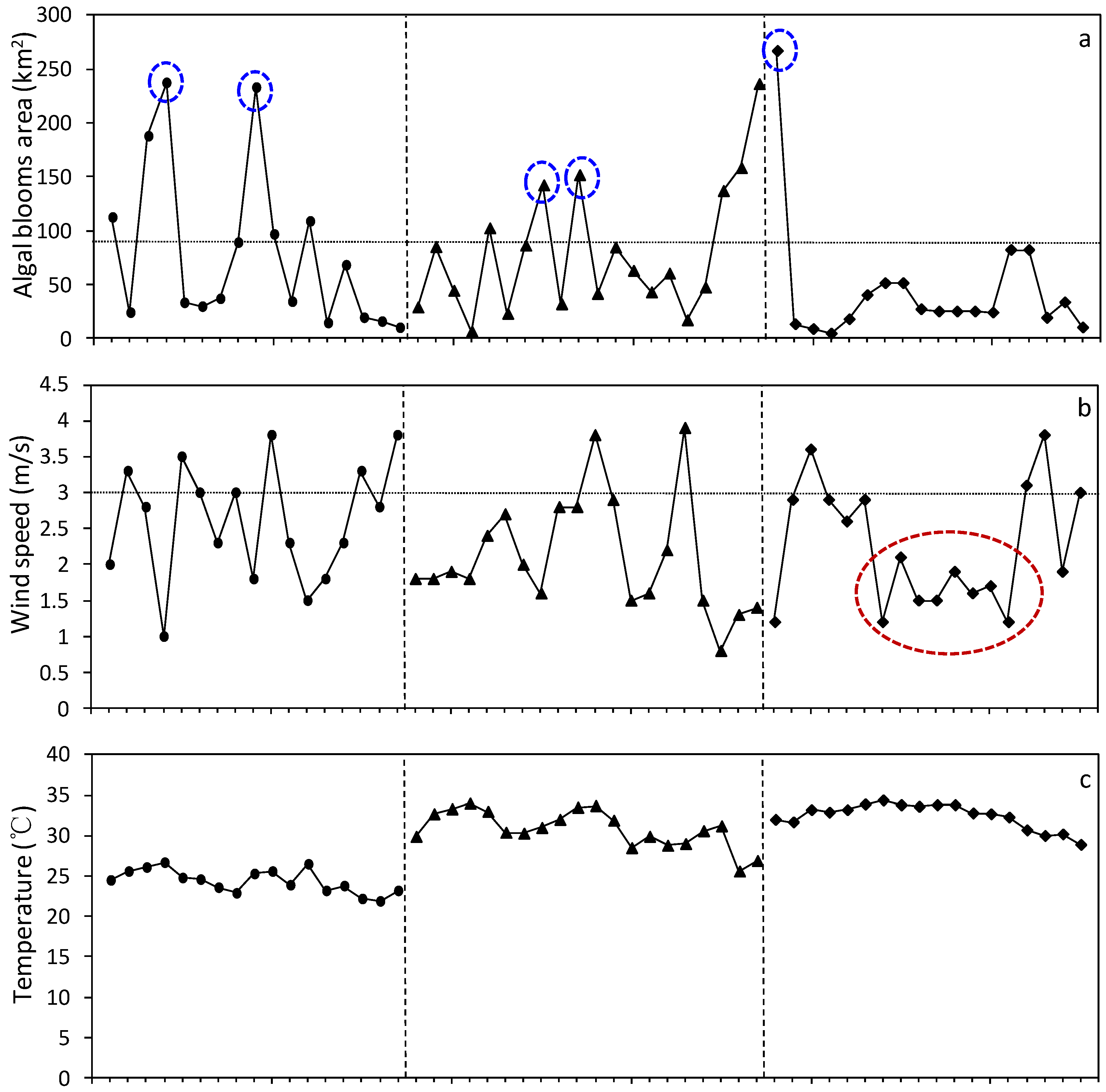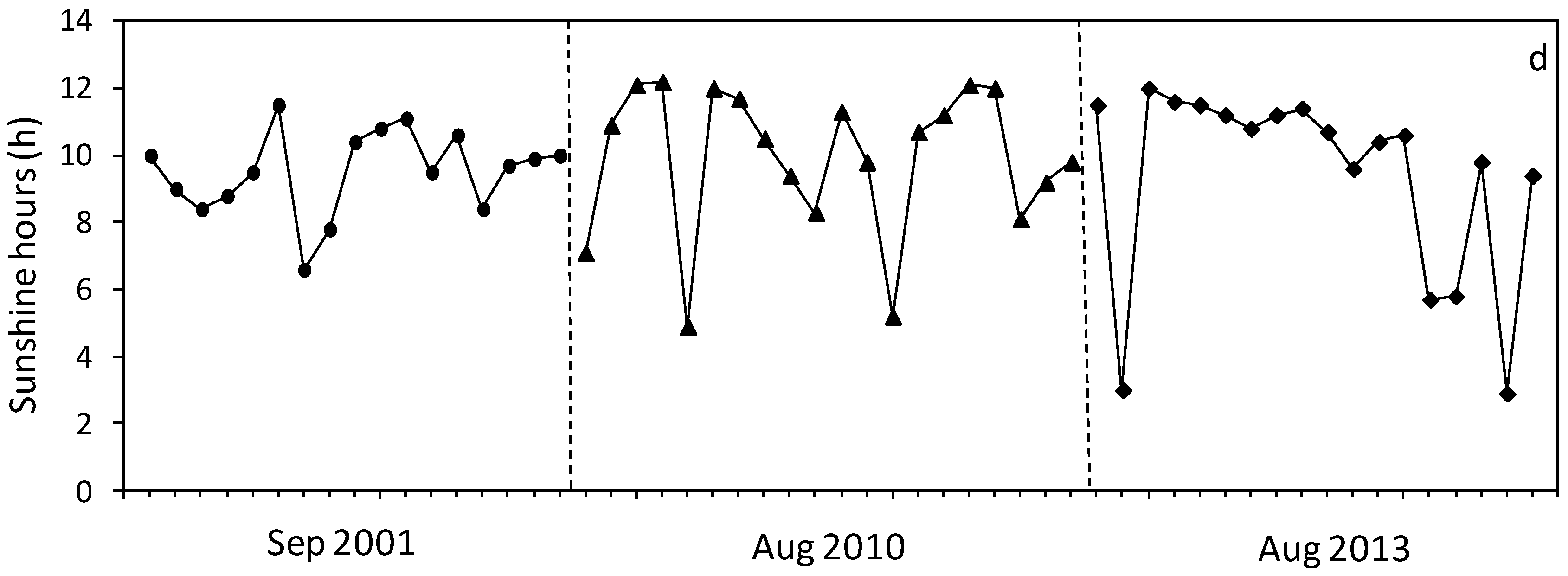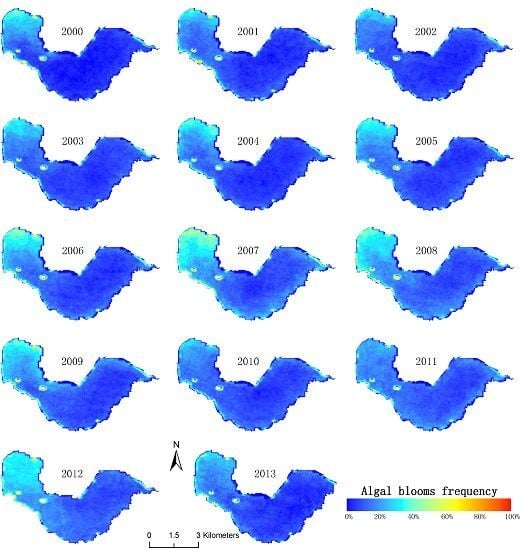4.1. Environmental Drivers of Inter-Annual Surface Bloom Dynamics
General increases in phytoplankton biomass, as well as increases in the frequency and duration of algal blooms, have been associated with an overall increase in nutrient inputs [
40]. Similar to other lakes in eastern China, Lake Chaohu is undergoing eutrophication due to the increase in population, economic activity, and wastewater generated in its catchment [
9]. Population, GDP, and waste increased from 7.88 million people, 53.9 billion RMB, and 18.7 million tons in 2000 to 33.3 million people, 342.6 billion RMB, and 118.8 million tons in 2010, respectively, with a significant increase after 2004 (
Figure 7). However, nutrient concentrations have behaved less uniformly: TN ranged from 1.5 to 3.0 mg/L and TP ranged from 0.15 to 0.23 mg/L [
7,
33,
34,
35,
36,
37]. TN showed a reduction from 0.33 mg/L in 2003 to 0.20 mg/L in 2011, and TP showed a decreasing trend. Despite these reductions, the average nutrient concentrations (TN: 2.20 ± 0.42 mg/L; TP: 0.18 ± 0.03mg/L) exceeded cyanobacteria growth requirements [
39,
41]. Although nutrient enrichment is a prerequisite to bloom formation, the role of nutrient concentrations in controlling floating algae bloom dynamics might be limited due to elevated concentrations and low inter-annual variation [
23,
27].
Figure 7.
Social and economic indices including GDP, population, and total waste in Lake Chaohu Basin, 1996 to 2010.
Figure 7.
Social and economic indices including GDP, population, and total waste in Lake Chaohu Basin, 1996 to 2010.
In high nutrient conditions, studies show that the magnitude, spatial extent, and duration of blooms are influenced by temperature, wind conditions (mixing), and solar insolation [
30,
42,
43,
44]. The average temperature had no significant trend in Lake Chaohu (
Figure 8a), even though ΔT
mean in 2002 and 2007 were 0.3 °C higher. ΔT
max showed two patterns: before 2008, it declined at a rate of 0.23 °C per year, except in 2003; after 2008 it increased by 0.29 °C per year (
Figure 8b). ΔT
min increased weakly except 2007, and the ΔT
min of 2007 is much higher than the other years (
Figure 8c). ΔP had no significant trend (
Figure 8d). The daily mean wind speed decreased by 1.1 m/s, and sunlight hours increased by 0.8 h over the 14 years. We compared the relationship between meteorological variables (ΔT
mean, ΔT
max, ΔT
min, ΔW, ΔP, and ΔS) and algal bloom dynamics (initiation date, duration, bloom significant days, and average bloom area) (
Table 4). As expected, wind anomaly had the highest correlation with the initial bloom date, bloom days, and average bloom area (
Table 2), with a poor correlation with duration (
Table 4). Precipitation was inversely correlated to duration. Sunlight hours from the meteorological station had a significant relationship with bloom coverage area and duration. This favors cyanobacteria accumulation at the water surface [
45,
46]. ΔT
max and ΔT
min were correlated with the initial bloom date and duration (
p < 0.05) (
Table 4).
Figure 8.
Trend in daily average anomalies of mean (a), maximum (b), and minimum (c) temperatures; precipitation (d); wind speed (e); and sunshine hours (f) during the period 2000–2013 for Lake Taihu. The line shows the linear regression against year.
Figure 8.
Trend in daily average anomalies of mean (a), maximum (b), and minimum (c) temperatures; precipitation (d); wind speed (e); and sunshine hours (f) during the period 2000–2013 for Lake Taihu. The line shows the linear regression against year.
Table 4.
Relationship between initial bloom date, duration, bloom significant days, and frequency of floating algae blooms in Lake Chaohu and climate variables.
Table 4.
Relationship between initial bloom date, duration, bloom significant days, and frequency of floating algae blooms in Lake Chaohu and climate variables.
| | | Initial Date | Duration | ΔTmean | ΔTmax | ΔTmin | ΔP | ΔW | ΔS |
|---|
| Initial date | r | 1.000 | −0.665 ** | −0.095 | 0.531 | −0.534 * | 0.074 | 0.597 * | −0.318 |
| Duration | r | −0.665 ** | 1.000 | 0.243 | −0.538 * | 0.701 ** | −0.497 | −0.476 | 0.464 |
| Significant days | r | −0.640 * | 0.564 * | 0.007 | −0.495 | 0.530 | −0.065 | −0.772 ** | 0.332 |
| Mean bloom area *** | r | −0.486 | 0.583 * | −0.368 | −0.464 | 0.308 | −0.203 | −0.796 ** | 0.592 |
Average air temperature, winter temperature (including the previous December to February) and effective temperatures for one week, two weeks, and a month before the initial bloom date were compared to the annual initial bloom date (
Table 5). No temperature thresholds were identified for average air temperature, winter temperature, and effective temperatures regarding the initial bloom date. In winter, the average temperature in the last decade was 4.6 (±1.0) °C, and the average chlorophyll a concentration was about 16.0 μg/L, allowing for enough cyanobacteria in the water column to create limited surface blooms with favorable conditions (
Figure 6).
Table 5.
General temperature features of floating algae at time of bloom formation in Lake Chaohu from 2000 to 2013.
Table 5.
General temperature features of floating algae at time of bloom formation in Lake Chaohu from 2000 to 2013.
| Year | Julian Day of Initial Time | Air Temperature (°C) | Winter Average Temperature (°C) | Effective Temperature (°C) * |
|---|
| One Week before Initial Time | Two Weeks before Initial Time | One Month before Initial Time |
|---|
| 2000 | 106 | 11.7 | 4.4 | 54.9 | 97 | 181.4 |
| 2001 | 115 | 18.6 | 4.7 | 38.2 | 81.7 | 139.8 |
| 2002 | 102 | 12 | 6.3 | 52.8 | 120.7 | 243.7 |
| 2003 | 145 | 22.4 | 4.6 | 96.1 | 177.7 | 341.4 |
| 2004 | 119 | 18.4 | 5.3 | 68.5 | 140.9 | 246.4 |
| 2005 | 69 | 16.8 | 3.3 | 1.2 | –24 | –133.6 |
| 2006 | 65 | 14.9 | 3.8 | –18.8 | –33.2 | –109.7 |
| 2007 | 45 | 8.5 | 5.7 | 2.6 | -0.9 | –84.7 |
| 2008 | 98 | 19.1 | 3.4 | 43 | 75.4 | 138.9 |
| 2009 | 68 | 12.2 | 5.3 | –23.1 | –55.5 | –54.1 |
| 2010 | 53 | 11.4 | 4.8 | –35.3 | –77.6 | –125.2 |
| 2011 | 70 | 10.2 | 4.1 | –4.5 | –28.7 | –103.4 |
| 2012 | 70 | 6.2 | 3.5 | –22.9 | –54.2 | –135.1 |
| 2013 | 101 | 14.9 | 3.9 | 39.6 | 80.4 | 108 |
4.2. Environmental Drivers of Monthly Surface Bloom Dynamics
Comparing monthly nutrient ratios and concentrations from three separate years (2008, 2012, and 2013) to monthly maximum bloom coverage (using monthly maxima), a significant negative correlation with TN (r = −0.503, N = 34) and TN/TP (r = −0.512, N = 34) was found (
Table 6). TN concentration increased in the spring when water levels were lowest and decreased in the summer when water levels were the highest, showing opposite trends to that of the bloom coverage. During periods of heavy surface blooms, TN:TP ratios ranged from 5:1 to 20:1 and TN concentrations were between 1.0 and 3.0 mg/L (
Figure 9a). Previous studies indicated that low TN:TP mass ratios favor both nitrogen-fixing and non-nitrogen-fixing cyanobacteria [
47]. In competition experiments,
Microcystis dominates at a TN:TP supply ratio < 44 [
48].
Due to the typical subtropical monsoon climate, only air temperature and precipitation showed seasonal behavior, as the seasonality of wind speed and sunshine hours was relatively weak (
Figure 9b). Temperature was hypothesized as a key factor in the growth and cessation of floating algae blooms [
49,
50]. Our results indicated that monthly average temperature covaried with maximum monthly bloom coverage (r = 0.677, n = 156).
Microcystis aeruginosa was shown to grow and enter the water column at 9 °C, resulting in a close correlation between algal recruitment and cumulative temperatures (sum of effective temperatures) [
32]. In Lake Chaohu, bloom expansion occurred from May to October when air temperatures were near or above 20 ℃. Cyanobacteria exhibit optimal growth rates at higher temperatures and compete more effectively with diatoms, chlorophytes, and cryptophytes [
51]. In a recent study of phytoplankton in Lake Chaohu, the photosynthetic rate of
M. wesenbergii was found to be greater than that of
M. viridis as temperature increased between spring and summer [
7]. When the temperature decreased between summer and autumn, this favored the growth of
M. aeruginosa. Similar changes occurred between autumn and winter, as
M. viridis replaced
M. aeruginosa.
While monthly average precipitation was also correlated with maximum monthly bloom coverage (r = 0.298, N = 156), a clear direct cause is unlikely and coincident temperature increases are a more likely determinant. Increases in cloudiness and direct precipitation inhibit the formation of floating algae blooms [
52].
The monthly average wind speed in Lake Chaohu was at its maximum in March (2.72 m/s) and at its minimum in October (1.92 m/s). Blooms occurred most frequently with a south wind before August, while an east wind prevailed in autumn, favoring an accumulation of surface blooms on the north coast of the west section.
Table 6.
Bivariate correlation analysis between monthly maxima algal bloom area and monthly water quality parameters.
Table 6.
Bivariate correlation analysis between monthly maxima algal bloom area and monthly water quality parameters.
| | | TN (mg/L) | TP (mg/L) | Transparency (cm) | TN/TP |
|---|
| Maximum algal bloom area (km2) | Pearson Correlation | −0.503 | 0.229 | 0.098 | −0.512 |
| Sig. (2-tailed) | 0.002 | 0.192 | 0.582 | 0.002 |
| N | 34 | 34 | 34 | 34 |
Figure 9.
(a) Nutrient concentration (TN) and stoichiometry (TN to TP ration) with monthly maximum algal bloom coverage in Lake Chaohu during three different years (2008, 2012, and 2013). Bubble size is monthly maximum algal bloom area. (b) Monthly variations of temperature, wind speed, precipitation, and sunshine hours from 2000 to 2014.
Figure 9.
(a) Nutrient concentration (TN) and stoichiometry (TN to TP ration) with monthly maximum algal bloom coverage in Lake Chaohu during three different years (2008, 2012, and 2013). Bubble size is monthly maximum algal bloom area. (b) Monthly variations of temperature, wind speed, precipitation, and sunshine hours from 2000 to 2014.
4.3. Environmental Drivers of Daily Surface Bloom Dynamics
Using consecutive daily images, it was possible to examine bloom dynamics in more detail (Figure 10). When the temperature was stable (consecutive days in September 2001, August 2010, and August 2013), a negative relationship between bloom area and daily wind speed occurred, confirming earlier observations in shallow waterbodies by George and Edwards [
29], and Hunter [
30]. Weak winds do not produce the needed turbulence to mix the algae cells [
31,
53], allowing them to congregate at the surface to a depth of 0.3 m [
54]. This was captured in the decrease in surface bloom area for 5–6 September 2001, showing a decrease from 237 km
2 with a wind speed of 1.0 m/s to 33 km
2 next day with a wind speed of 3.5 m/s (
Figure 10b).
Similar dynamics occurred for 12–13 September 2001, 10–12 August 2010, and 2–3 August 2013 (
Figure 10). It is unlikely that an extensive floating algae biomass could appear or disappear in a single day. In fact, without knowledge of the vertical distribution of the algae, the surface biomass delivered from satellite data cannot be used to determine the total cyanobacteria biomass. We can only assume that total biomass values are underestimated when wind conditions are elevated [
44].
Figure 10.
Three examples of daily algal bloom area, wind speed, temperature, and sunshine hours. The blue circles mark the examples where floating bloom area changed because of the wind speed. The red circle shows an example where low winds were not followed by severe blooms.
Figure 10.
Three examples of daily algal bloom area, wind speed, temperature, and sunshine hours. The blue circles mark the examples where floating bloom area changed because of the wind speed. The red circle shows an example where low winds were not followed by severe blooms.
The results show that severe algal blooms (>80 km
2) took place when wind speed was below 3.0 m/s. However, low winds were not always followed by severe blooms, under appropriate temperature and insolation conditions. For example, algal bloom area was no more than 50 km
2 with persistent low wind (<2 m/s) for 10–17 August 2013, with air temperatures above 32 °C and sunshine hours of 10 hours each day. In this case, heavy blooms did not occur even with the low average wind, high temperature, and insolation, possibly due to a lag in bloom formation due to daily variability in wind speed, observed to have an amplitude of 0.6–1.1 m/s [
55]. In the present study, we use the daily average wind speed, which might be not sufficient to explain instantaneous bloom conditions during the satellite passage. Another possibility may be that elevated temperatures may be above the optimal temperature for the species present, even while favoring thermal stratification [
56].
